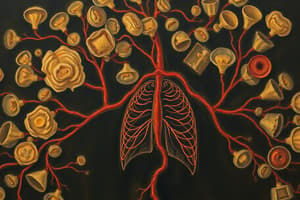Podcast
Questions and Answers
What primarily drives the movement of oxygen from the alveoli into the blood?
What primarily drives the movement of oxygen from the alveoli into the blood?
- Partial pressure gradients (correct)
- Thickness of the alveolar wall
- Concentration of CO2 in the blood
- Presence of alveolar surfactant
Which anatomical structures are primarily involved in gas exchange?
Which anatomical structures are primarily involved in gas exchange?
- Alveoli and capillaries (correct)
- Pleura and bronchi
- Lungs and diaphragm
- Bronchioles and trachea
What factor would most likely impair the efficiency of gas exchange?
What factor would most likely impair the efficiency of gas exchange?
- Thinner alveolar-capillary membrane
- Normal ventilation-perfusion ratio
- Higher thickness of alveolar-capillary membrane (correct)
- Increased surface area of alveoli
Which condition can lead to respiratory failure by disrupting gas exchange mechanisms?
Which condition can lead to respiratory failure by disrupting gas exchange mechanisms?
What is the primary regulator of breathing in response to CO2 levels?
What is the primary regulator of breathing in response to CO2 levels?
Flashcards are hidden until you start studying
Study Notes
Gas Exchange Mechanisms
-
Definition: Gas exchange refers to the process of transferring oxygen (O2) and carbon dioxide (CO2) between the alveoli and the bloodstream.
-
Anatomical Structures Involved:
- Alveoli: Tiny air sacs in the lungs where gas exchange occurs. They have thin walls to facilitate diffusion.
- Capillaries: Microvessels surrounding alveoli that transport blood and allow for gas exchange.
- Bronchioles: Airways leading to the alveoli that help distribute air throughout the lungs.
-
Types of Gas Exchange:
-
External Respiration:
- Occurs in the lungs.
- O2 is inhaled into the alveoli and diffuses into the capillary blood.
- CO2 diffuses from the blood into the alveoli to be exhaled.
-
Internal Respiration:
- Occurs in body tissues.
- O2 is transported from the blood into cells.
- CO2 produced by cellular metabolism diffuses from cells into the blood.
-
-
Mechanisms of Gas Exchange:
- Diffusion: Gas molecules move from areas of higher concentration to lower concentration.
- Partial Pressure Gradients: Driving force for gas exchange; O2 moves from areas of higher partial pressure (in alveoli) to lower (in blood) and vice versa for CO2.
-
Factors Affecting Gas Exchange:
- Surface Area: Larger surface area of alveoli enhances gas exchange.
- Thickness of Membrane: Thinner alveolar-capillary membrane allows for quicker diffusion.
- Ventilation-Perfusion Ratio (V/Q): Ideal ratio promotes optimal gas exchange; mismatches can lead to inefficient gas exchange.
-
Control of Breathing:
- Regulated by the respiratory center in the brainstem.
- Responds to chemical signals (e.g., CO2 levels) to adjust breathing rate and depth.
-
Pathophysiological Considerations:
- Respiratory Failure: Occurs when gas exchange is impaired, leading to hypoxemia (low O2) and/or hypercapnia (high CO2).
- Conditions such as pneumonia, COPD, and pulmonary edema can disrupt gas exchange mechanisms.
Gas Exchange Mechanisms
- Gas exchange is the transfer of oxygen (O2) and carbon dioxide (CO2) between alveoli and the bloodstream.
- Anatomical Structures:
- Alveoli: Small air sacs in the lungs that facilitate gas exchange due to their thin walls.
- Capillaries: Microscopic blood vessels surrounding alveoli that transport blood for gas exchange.
- Bronchioles: Airways that lead to the alveoli, aiding in the distribution of air in the lungs.
Types of Gas Exchange
- External Respiration:
- Takes place in the lungs where O2 enters the alveoli and diffuses into the capillary blood; CO2 diffuses from blood into alveoli to be exhaled.
- Internal Respiration:
- Occurs in body tissues; O2 moves from blood into cells, and CO2 produced by cellular metabolism moves from cells back into blood.
Mechanisms of Gas Exchange
- Diffusion: Gas molecules inherently travel from regions of high concentration to low concentration.
- Partial Pressure Gradients: The driving force; O2 moves from higher partial pressure (in alveoli) to lower (in blood) while CO2 moves in the opposite direction.
Factors Affecting Gas Exchange
- Surface Area: A larger alveolar surface area increases efficiency of gas exchange.
- Thickness of the Membrane: Thinner alveolar-capillary membranes speed up the diffusion process.
- Ventilation-Perfusion Ratio (V/Q): An ideal ratio ensures optimal gas exchange; mismatches can cause inefficiencies.
Control of Breathing
- Breathing is regulated by the respiratory center in the brainstem, which responds to chemical signals (such as CO2 levels) to modify the rate and depth of breathing.
Pathophysiological Considerations
- Respiratory Failure: Occurs when gas exchange is disrupted, resulting in hypoxemia (low O2 levels) and/or hypercapnia (high CO2 levels).
- Conditions like pneumonia, chronic obstructive pulmonary disease (COPD), and pulmonary edema can severely impair gas exchange mechanisms.
Studying That Suits You
Use AI to generate personalized quizzes and flashcards to suit your learning preferences.




